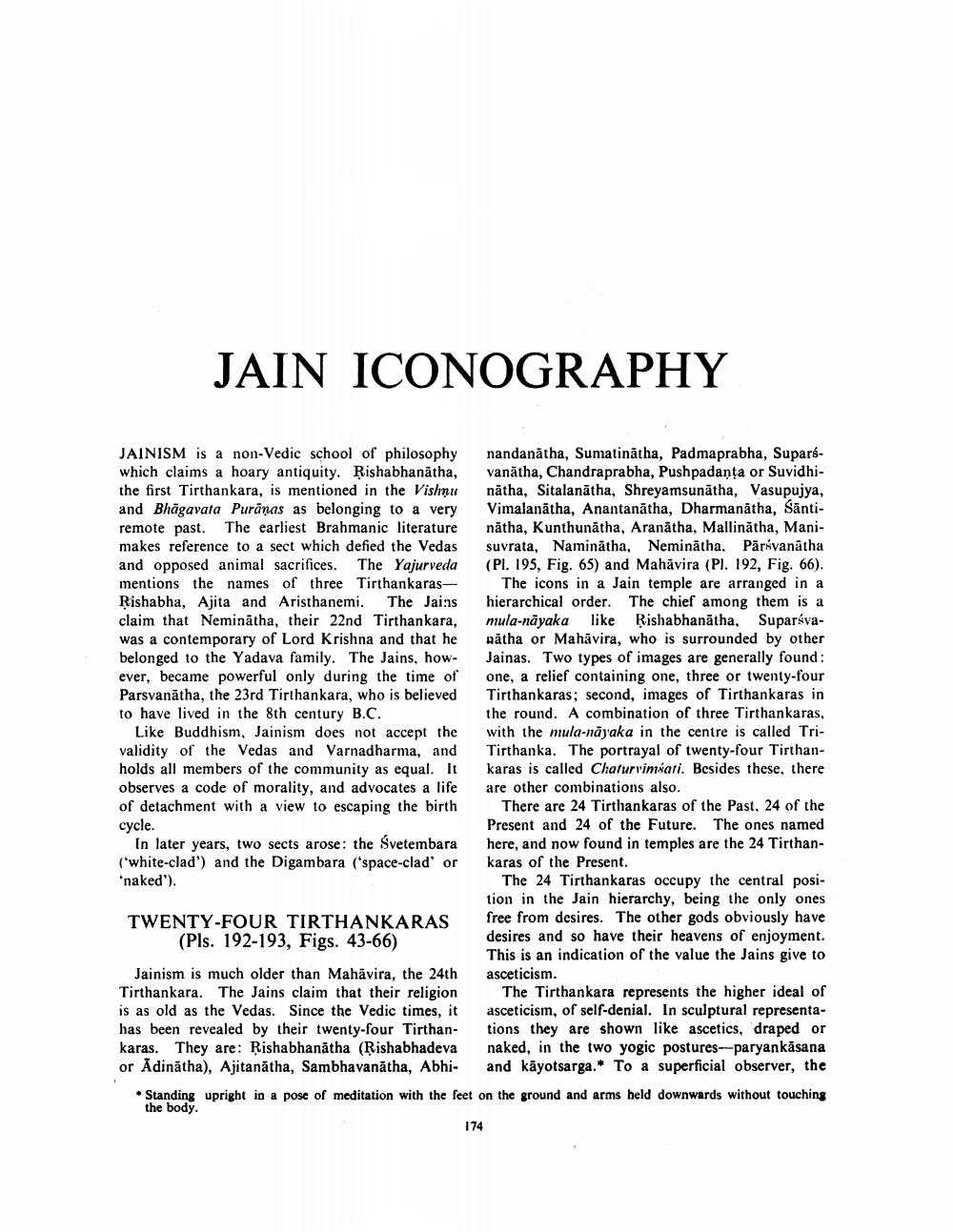________________
JAIN ICONOGRAPHY
JAINISM is a non-Vedic school of philosophy which claims a hoary antiquity. Rishabhanatha, the first Tirthankara, is mentioned in the Vishnu and Bhagavata Puranas as belonging to a very remote past. The earliest Brahmanic literature makes reference to a sect which defied the Vedas and opposed animal sacrifices. The Yajurveda mentions the names of three TirthankarasRishabha, Ajita and Aristhanemi. The Jains claim that Neminatha, their 22nd Tirthankara, was a contemporary of Lord Krishna and that he belonged to the Yadava family. The Jains, however, became powerful only during the time of Parsvanatha, the 23rd Tirthankara, who is believed to have lived in the 8th century B.C.
Like Buddhism, Jainism does not accept the validity of the Vedas and Varnadharma, and holds all members of the community as equal. It observes a code of morality, and advocates a life of detachment with a view to escaping the birth cycle.
In later years, two sects arose: the Svetembara ('white-clad') and the Digambara ('space-clad' or 'naked').
TWENTY-FOUR TIRTHANKARAS (Pls. 192-193, Figs. 43-66)
Jainism is much older than Mahavira, the 24th Tirthankara. The Jains claim that their religion is as old as the Vedas. Since the Vedic times, it has been revealed by their twenty-four Tirthankaras. They are: Rishabhanatha (Rishabhadeva or Adinatha), Ajitanatha, Sambhavanatha, Abhi
nandanatha, Sumatinatha, Padmaprabha, Suparévanatha, Chandraprabha, Pushpadanța or Suvidhinatha, Sitalanatha, Shreyamsunātha, Vasupujya, Vimalanatha, Anantanatha, Dharmanatha, Santinätha, Kunthunatha, Aranatha, Mallinatha, Manisuvrata, Naminätha, Neminatha. Pärsvanatha (Pl. 195, Fig. 65) and Mahavira (Pl. 192, Fig. 66).
The icons in a Jain temple are arranged in a hierarchical order. The chief among them is a mula-nayaka like Rishabhanatha, Suparvanätha or Mahavira, who is surrounded by other Jainas. Two types of images are generally found: one, a relief containing one, three or twenty-four Tirthankaras; second, images of Tirthankaras in the round. A combination of three Tirthankaras, with the mula-nayaka in the centre is called TriTirthanka. The portrayal of twenty-four Tirthankaras is called Chaturvimsati. Besides these, there are other combinations also.
174
There are 24 Tirthankaras of the Past, 24 of the Present and 24 of the Future. The ones named here, and now found in temples are the 24 Tirthankaras of the Present.
The 24 Tirthankaras occupy the central position in the Jain hierarchy, being the only ones free from desires. The other gods obviously have desires and so have their heavens of enjoyment. This is an indication of the value the Jains give to asceticism.
The Tirthankara represents the higher ideal of asceticism, of self-denial. In sculptural representations they are shown like ascetics, draped or naked, in the two yogic postures-paryankāsana and kayotsarga. To a superficial observer, the
*Standing upright in a pose of meditation with the feet on the ground and arms held downwards without touching the body.




